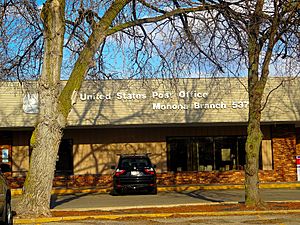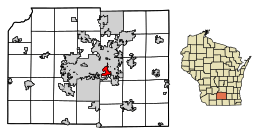Monona, Wisconsin facts for kids
Quick facts for kids
Monona, Wisconsin
|
|
|---|---|

Monona post office
|
|

Location of Monona in Dane County, Wisconsin.
|
|
| Country | |
| State | |
| County | Dane |
| Incorporated | August 29, 1938 |
| Government | |
| • Type | City Council/Mayor |
| Area | |
| • Total | 3.35 sq mi (8.68 km2) |
| • Land | 3.26 sq mi (8.44 km2) |
| • Water | 0.09 sq mi (0.24 km2) |
| Elevation | 879 ft (268 m) |
| Population
(2020)
|
|
| • Total | 8,624 |
| • Density | 2,508.44/sq mi (968.45/km2) |
| Time zone | UTC-6 (Central (CST)) |
| • Summer (DST) | UTC-5 (CDT) |
| ZIP code |
53716
|
| Area code(s) | 608 |
| FIPS code | 55-53675 |
| GNIS feature ID | 1569653 |
Monona is a city in Dane County, Wisconsin, United States. It is a suburb of Madison, the state capital. The city is located on the southeastern shore of Lake Monona, which is where it gets its name. In 2020, about 8,624 people lived in Monona.
Contents
History of Monona
Monona started as part of the Town of Blooming Grove. On August 29, 1938, it officially became a village. Before 1938, the area was mostly farmland and places where people had summer homes. But by 1938, more permanent houses and small shops had been built.
During the 1950s, Monona grew a lot. The number of people living there went from 2,544 to 8,178. As the city grew, new buildings were needed. In 1963, Monona built a community center and a swimming pool next to it. A public library was added in 1967. In 1969, Monona became a city, and a city hall was built across from the library. This building now holds all the city's offices, including the fire and police departments.
Ancient Indian Mounds Discovered
In the 1940s, something very old was found in Monona. During street construction, a mound was accidentally cut into, and ancient skeletons were uncovered. This was an Indian burial mound, believed to have been built by the Hopewell Indians about 1,500 to 2,000 years ago.
In 1998, a special Wisconsin historical marker was placed at this site. It tells the story of the "Outlet Mound." This mound was the largest of 19 similar mounds once found nearby. These mounds were built by early Native Americans, known as Woodland Indians, as burial places. The Wisconsin Archeological Society and local citizens helped save the mound from being destroyed in 1944. They then gave it to the City of Monona.
Today, the area where the mound was found is called Indian Mounds Park. You can find it at the corner of Midwood and Ridgewood Avenues. In 2003, this important site was added to the National Register of Historic Places, which means it's a special place worth protecting.
Geography and Location
Monona is located in Wisconsin at coordinates 43°3′25″N 89°20′1″W / 43.05694°N 89.33361°W. The city covers a total area of about 3.35 square miles (8.68 square kilometers). Most of this area is land, about 3.26 square miles (8.44 square kilometers). A smaller part, about 0.09 square miles (0.24 square kilometers), is water, mainly from Lake Monona.
Population of Monona
Monona has grown quite a bit over the years. Here's how its population has changed:
| Historical population | |||
|---|---|---|---|
| Census | Pop. | %± | |
| 1940 | 1,323 | — | |
| 1950 | 2,544 | 92.3% | |
| 1960 | 8,178 | 221.5% | |
| 1970 | 10,420 | 27.4% | |
| 1980 | 8,809 | −15.5% | |
| 1990 | 8,637 | −2.0% | |
| 2000 | 8,018 | −7.2% | |
| 2010 | 7,533 | −6.0% | |
| 2020 | 8,624 | 14.5% | |
| U.S. Decennial Census | |||
Monona's Community in 2010
According to the 2010 census, there were 7,533 people living in Monona. There were 3,777 households, which are groups of people living together. About 20% of these households had children under 18. Many households were married couples, and some were single-parent families.
The average age of people in Monona in 2010 was about 45.9 years old. About 16.9% of the residents were under 18, and 19.5% were 65 or older. The city had slightly more females (52.3%) than males (47.7%).
Local Economy
Monona is home to a few interesting organizations and businesses. The Sand County Foundation is located here. This group works to protect and improve land for people and nature. Also, the Widen software company has its offices in Monona.
See also
 In Spanish: Monona (Wisconsin) para niños
In Spanish: Monona (Wisconsin) para niños


